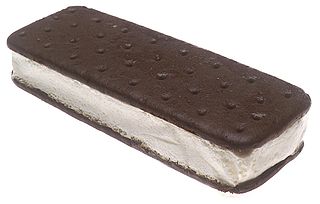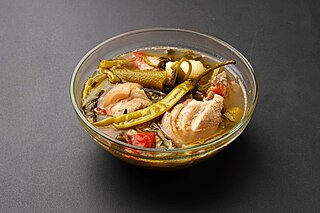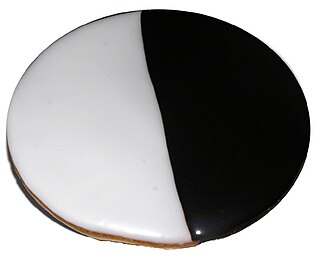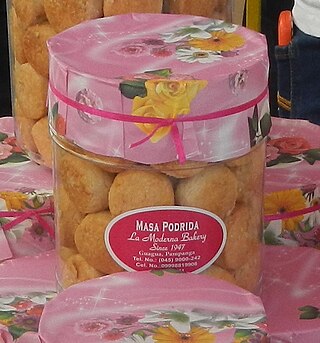 | |
| Type | Cookie |
|---|---|
| Place of origin | Philippines |
A half-moon cookie in Filipino cuisine is a semicircle- or crescent-shaped butter cookie. It has a soft crumbly texture and a sweet flavor with a salty aftertaste. [1] [2] [3] [4]
 | |
| Type | Cookie |
|---|---|
| Place of origin | Philippines |
A half-moon cookie in Filipino cuisine is a semicircle- or crescent-shaped butter cookie. It has a soft crumbly texture and a sweet flavor with a salty aftertaste. [1] [2] [3] [4]

Western Visayas is an administrative region in the Philippines, numerically designated as Region VI. It consists of six provinces and two highly urbanized cities. The regional center is Iloilo City. The region is dominated by the native speakers of four Visayan languages: Hiligaynon, Kinaray-a, Aklanon and Capiznon. The land area of the region is 20,794.18 km2 (8,028.68 sq mi), and with a population of 7,954,723 inhabitants, it is the second most populous region in the Visayas after Central Visayas.

An ice cream sandwich is a frozen dessert consisting of ice cream between two biscuits, wafers, cookies, or baked goods. The ingredients are different around the world, with Ireland using wafers and the United States commonly using cookies.

Maxibon is a Belgian brand of ice cream sandwich made by Froneri, and also previously owned by the Swiss company Nestlé. It consists of a block of frozen dairy dessert containing small chocolate chips with one end covered in chocolate, and the other sandwiched between two biscuits.

Iloilo City, officially the City of Iloilo, is a 1st class highly urbanized city in the Western Visayas region of the Philippines, located on the southeastern coast of the island of Panay. It is the capital city of the province of Iloilo, where it is geographically situated and grouped under the Philippine Statistics Authority, but remains politically independent in terms of government and administration. In addition, it is the center of the Iloilo–Guimaras Metropolitan Area, as well as the regional center and primate city of the Western Visayas region. According to the 2020 census, Iloilo City has a population of 457,626 people. For the metropolitan area, the total population is 1,007,945 people.

Sinigang is a Filipino soup or stew characterized by its sour and savory taste. It is most often associated with tamarind, although it can use other sour fruits and leaves as the souring agent. It is one of the more popular dishes in Filipino cuisine. The soup is usually accompanied by rice.

Biscocho, also spelled biskotso, refers to various types of Filipino twice-baked breads, usually coated with butter and sugar, or garlic in some cases. Biscocho is most strongly associated with the versions from the province of Iloilo, although it actually exists nationwide in various forms. It is also known as biscocho duro, machacao, or matsakaw. It is also historically known as pan de caña.

Black-and-white cookies, half-and-half cookies, and half-moon cookies are similar round cookies iced or frosted in two colors, with one half vanilla and the other chocolate. They are found in the Northeastern United States and Florida. Black-and-white cookies are flat, have fondant or sometimes royal icing on a dense cake base, and are common in the New York metropolitan area. Half-moon cookies are slightly dome-shaped (convex), have frosting on a fluffy angel cake base, and are common in Central New York and Boston, Massachusetts.
Ohaldres are Filipino puff pastries originating from the Visayas Islands. They are very similar to utap, and are sometimes considered a type of utap, but they have a denser texture and are sliced thicker. They are usually baked as tight spirals or double whorls and are around 1 to 3 in in diameter.

Puto is a Filipino steamed rice cake, traditionally made from slightly fermented rice dough (galapong). It is eaten as is or as an accompaniment to a number of savoury dishes. Puto is also an umbrella term for various kinds of indigenous steamed cakes, including those made without rice. It is a sub-type of kakanin.

Sinangag, also called garlic fried rice or garlic rice, is a Filipino fried rice dish cooked by stir-frying pre-cooked rice with garlic. The rice used is preferably stale, usually leftover cooked rice from the previous day, as it results in rice that is slightly fermented and firmer. It is garnished with toasted garlic, rock salt, black pepper and sometimes chopped scallions. The rice grains are ideally loose and not stuck together.

Silvanas, alternatively spelled as sylvanas or sylvannas, is a Filipino frozen cookie consisting of a layer of buttercream sandwiched between two cashew-meringue wafers coated with cookie crumbs. Silvanas are the cookie versions of the sans rival, a Filipino cake made from similar ingredients.

A sandwich cookie, also known as a sandwich biscuit, is a type of cookie made from two thin cookies or medium cookies with a filling between them. Many types of fillings are used, such as cream, ganache, buttercream, chocolate, cream cheese, jam, peanut butter, lemon curd, or ice cream.

Barquillo is a crispy rolled wafer pastry originating in Spain. It is made from the basic cookie ingredients of flour, sugar, egg whites and butter rolled out thinly and then shaped into a hollow cylinder or a cone. It was traditionally sold by roadside vendors known as barquilleros who carried a characteristic red roulette tin. It was introduced to Latin America and the Philippines during colonial times. In Spain and former Spanish colonies, barquillos are commonly regarded as a type of Christmas cookie. It is also popular during various fiestas. It spread to neighboring countries and today is extremely popular in East and Southeast Asian countries.

In Philippine cuisine, roscas or biscochos de roscas refer to a type of pastry cookies from the province of Leyte, mainly from the towns of Barugo and Carigara, made from lard, anise, flour, sugar, butter and eggs. These roscas are initially shaped as crescents or penannular rings. Each of the roscas is then cut in half before baking, resulting in two separate elbow-shaped cookies.

Paborita are Filipino disc-shaped biscuits with a flaky texture. They are made with wheat flour, sugar, skim milk, salt, baking powder, alum, and cooking oil. They are very similar in taste to galletas de patatas. They are traditionally eaten paired with hot drinks or with fruit preserves.

Ugoy-ugoy, also spelled ogoy-ogoy, are Filipino layered biscuits. They are typically rectangular or ribbon-like in shape and are topped with granulated sugar. It is particularly associated with the city of Iloilo.

Masa podrida are traditional Filipino shortbread cookies made from flour, salt, baking powder, brown sugar, shortening, and eggs. It has a dry crumbly texture similar to half-moon cookies. The name comes from Spanish for "rotten dough". Masa podrida are typically eaten with coffee and other hot drinks.

Pinasugbo, also known as consilva, is a Filipino banana chip dessert made from thinly sliced saba bananas that are deep-fried and coated with caramelized sugar and sesame seeds. It originates from the Hiligaynon people of the Western Visayas islands. It is traditionally sold in white paper cones.